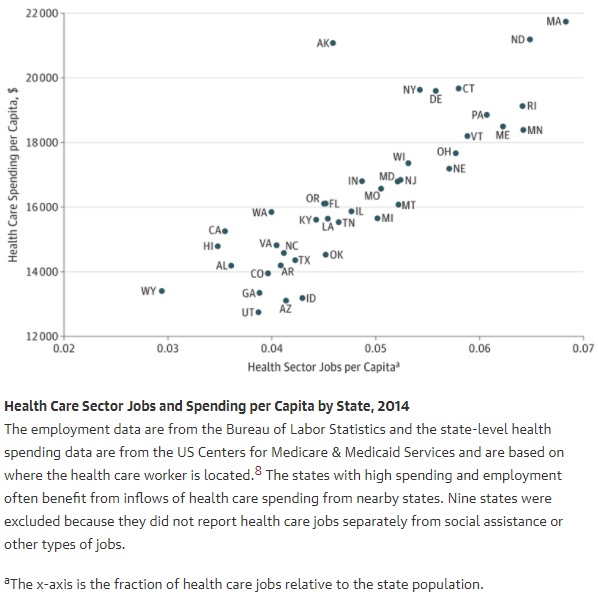Slowing Employment Key to Reducing Healthcare Costs, Experts Argue
A new study shows growth in healthcare costs correlates to healthcare employment growth, meaning the industry needs to scale back hiring to effectively reduce spending.

Source: Thinkstock
- Despite industry-wide efforts to cut spending, healthcare costs are unlikely to decrease unless the industry also reduces the growth in employment, professors from the Geisel School of Medicine, Dartmouth College and Kennedy School of Government, Harvard University recently argued.
In a new JAMA viewpoint report, Jonathan Skinner, PhD, and Amitabh Chandra, PhD, showed that healthcare spending is related to employment using 2014 state-level data on healthcare costs and 2014 healthcare employment information.
In every state except Alaska, where wages were usually high, healthcare costs rose alongside employment.

Source: JAMA
“This is an association and not causation so the reverse could also be true with increased spending associated with more jobs,” Skinner and Chandra explained. “However, the point remains that efforts to reduce costs are unlikely to be successful without scaling back job growth in healthcare.”
CMS Office of the Actuary recently projected healthcare to represent almost 20 percent of the economy by 2026.
READ MORE: Healthcare Employment Increases Challenge Provider Orgs
And as healthcare spending grows, so is employment in the industry. Despite a recession from December 2007 to June 2009, healthcare employment increased at an annual rate of 2.1 percent into 2018, and the healthcare sector added 2.8 million jobs between December 2007 and December 2017, Altarum reported.
Professors Skinner and Chandra were not shocked by the association between healthcare costs and employment growth. “It is not surprising that employment growth should be a bellwether for rising healthcare expenditures because salaries and wages account for an average 55 percent of operating expenses for hospitals, physician offices, and outpatient care, and nearly 70 percent of hospital expenses,” they wrote.
The association between spending and employment is particularly strong in healthcare because of the prevalence of non-profit statuses among hospitals, the experts explained.
Of the 5,534 registered hospitals in the US, over 2,800 are non-profit, while just 1,035 are for-profit, according to 2018 data from the American Hospital Association. The rest are state or local government community hospitals (956), federal government hospitals (209), non-federal psychiatric hospitals (394), or owned by another source (88).
Non-profit organizations must expand their services when faced with a profit, rather than return profits to shareholders and modify employment as in a for-profit organization. For example, hospitals seeing a 10 percent growth in Medicare reimbursement rates added new technology, increased nursing staff by 16 percent, and boosted payroll by almost one-third, a cited 2017 National Bureau of Economic Research working paper showed.
READ MORE: Managing Healthcare Costs, Data Analytics Top C-Suite Priorities
Recent technological advancements and healthcare reforms also strengthened the relationship between spending and employment, researchers explained.
“The healthcare sector is characterized by ever-new technological innovations, but most are labor intensive, cannot be outsourced, and their extra costs can be passed along to third-party payers and consumers, especially when hospitals have market power to raise prices,” Skinner and Chandra wrote.
“Unlike retail and manufacturing industries in which technology changes enhance labor productivity, electronic health records (EHRs) have added to the required human workload, whether this involves physicians and nurses spending many more hours entering information into the EHR, hiring scribes to accompany clinicians to enter this information, or paying support staff for EHR infrastructure investments.”
On top of EHR implementation, the Affordable Care Act and value-based purchasing adoption may have added to the healthcare workforce. The legislation and alternative payment models require healthcare organizations to reduce costs while improving care quality, preventative care, and population health.
But these cost-reduction and care quality improvement initiatives require staff to implement.
READ MORE: What Is Healthcare Revenue Cycle Management?
“Employees of hospitals and clinics are busy and because they do not have time to effect cost-saving innovations, these organizations often hire new employees to implement the cost-saving innovations,” the academics stated. “It is certainly possible that the innovations will lead to longer-term reductions in the number of employees by reducing redundancy, increasing care coordination, and improving efficiencies, but there is no evidence to date (at least in the aggregate) to support that possibility.”
“Moreover, these new tasks such as care coordination and population health may improve health outcomes but represent new salary expenses, thus reducing the likelihood that overall spending will decline or plateau.”
To actually lower healthcare costs, the industry must address the growth in employment.
However, hiring freezes, reducing administrator salaries, and other short-term policies will not drive sustainable reductions in spending and employment, the experts stated. Hiring freezes merely keep outdated worker allocations, stop the hiring of needed staff, and increase the workload of existing employees. Reducing salaries also has a minimal effect on the large budgets of health systems and hospitals.
“Instead, the focus should be on restraining overall hiring by right-sizing jobs to employees who can best perform them at the lowest cost or by closing inefficient facilities,” Skinner and Chandra advised. “Similarly, the urge to expand employment using unexpectedly healthy profit margins should be resisted because it is easier to create new positions than it is to lay off workers in a less sanguine future.”
The academics also recommended that healthcare organizations look to the human resources department for scaling back employment.
“This department, at least in most hospitals, has rarely had to lay off employees because healthcare has been a recession-free industry for several decades,” they explained. “This will eventually change either because of private efforts, government efforts, or both.”
